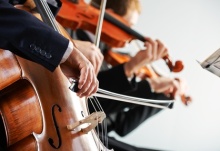
I have always been fascinated when I hear an orchestra play without conductor. Interpretation issues aside, how do the musicians stay so expertly in sync through all of the nuances and flexibilities of tempo? A few weeks ago I heard the St. Paul Chamber Orchestra in a concert that included the Beethoven Third Symphony. I know the Eroica well, but heard it that night as though for the first time. The thirty-six musicians played without conductor and the performance was electrifying – slightly faster tempos than usual, but with a great deal of flexibility; absolute clarity, making it possible to hear voices one doesn’t always hear; and an emotional intensity that is often missing when a group has played a Beethoven symphony countless numbers of times.
I was sitting in the orchestra section, quite near the front of the hall, so I was able to see the musicians’ faces clearly. There was a great deal of eye contact among various members of the orchestra. They were totally responsive to each other as well as to the music. They acted as though they were playing in a quartet rather than in an orchestra of thirty-six musicians.
I couldn’t help but think about that concert when I came across some recent research about beat-deafness. Now I know you are wondering what the connection could possibly be between an orchestra playing with a great deal of synergy – without conductor – and beat-deafness.
We expect that an orchestra will play together – no player is out of sync or he wouldn’t keep his job. Everyone synchronizes with the same beat, whether the beat is supplied externally by a conductor, or whether it is internalized by all of the players as was the case in this concert with the SPCO. That ability to synchronize to a beat or rhythm is called entrainment.
Beat-based entrainment ability is necessary for many activities – from playing or singing music together, to rowing on a crew team, dancing, skating to music, or marching in a band or military formation. I’ve even seen a roofer synchronize to a beat when he is pounding roofing nails into the shingles (not a necessity, but certainly impressive). The members of the conductorless SPCO were all entrained to the same beat, rhythm, tempo – and remained so, even as the music subtly changed tempo, adding all of the nuance that is so necessary for a musical performance. That ability to entrain to the beat is a given for any musician.
The audience also entrains to the rhythm or beat of the music. As I looked around, I saw a few heads nodding in time, but for the most part, people at a classical music concert are a pretty staid bunch. Most of them no doubt feel the beat, but they don’t tend to move to the music, to bob their heads or tap their fingers – not considered good concert etiquette.
In the club scene, however, or at a rock concert, everyone taps feet, moves bodies and physically “shows” the beat. Music seems to compel us to move in synchronization with the rhythm. Most of us – that is. A very few people don’t have that ability and those individuals are suffering from a sensory deficit called beat-deafness.
We have all heard someone claim that they are “tone-deaf” and can’t sing a note, although most people who claim to be tone-deaf are actually not. Tone-deafness, or congenital amusia, is the inability to distinguish between musical pitches – in spite of musical training. Some people are unable to hear or reproduce melodies. It is usually genetic, although sometimes results from brain damage. Actual tone-deafness is rare.
Beat-deafness is another form of congenital amusia and is a sensory deficit, as is tone-deafness or color-blindness. A person who is tone-deaf is unable to sing because he can’t match pitches nor tell the difference between them. A person who is beat-deaf is not able to synchronize his body with the rhythms he hears. Like tone-deafness, it is also very rare.
Is this ability to entrain to a beat innate, or do we learn it at some point in our early  development? Some years ago, it was determined that newborns two to three days old could detect the beat in music. This ability had previously been thought to be learned in the first few months of life. But a study conducted by researchers in Hungary and the Netherlands demonstrated that this ability is either innate or learned in the womb.
development? Some years ago, it was determined that newborns two to three days old could detect the beat in music. This ability had previously been thought to be learned in the first few months of life. But a study conducted by researchers in Hungary and the Netherlands demonstrated that this ability is either innate or learned in the womb.
Researchers used scalp electrodes to measure electrical brain signals in the babies as they slept while music with a regular rock rhythm was being played to them. Several variants were played with different beats being omitted in each version. When beats other than the downbeat were omitted, there was no brain response in the babies. But when the downbeat was omitted, the babies’ brains produced an electrical response. It seems the babies wanted to hear the downbeat.
In later studies conducted in Finland and the UK, infants between two months and five years were shown to move to music. They showed a definite response to rhythm, moving faster as the music was faster, and slower when the music or rhythm slowed down. And believe it or not, the babies who were better able to synchronize to the rhythm smiled more. Most children don’t have the motor control to actually synchronize with a beat until the age of 4 or 5, but 3-yr. old Jonathan in this YouTube video shows a remarkably well-developed entrainment ability. Jonathan is very happily conducting Beethoven.
So we apparently have a beat-tracking mechanism in place from birth, a sort of inner time-keeping mechanism.
But researchers at McGill University and the University of Montreal have discovered that there are a few individuals who do not have this ability to track a beat. The beat deafness is not a lack of hearing rhythm, but an inability to translate an auditory stimulus into a motor response. They can hear the rhythm, but can’t match a motor movement to what they hear.
The auditory and motor systems in the brain are highly integrated in a musician, as we talked about in an earlier post (Setting the stage for auditory mirror neurons: the auditory-motor loop), and by studying the deficits in synchronization in someone with beat-deafness, researchers learn more about the integration of the auditory and motor areas.
 While many people say they have “two left feet,” and are unable to dance, beat-deafness is extremely rare. Out of hundreds of people who responded to an ad seeking participants for the McGill and Univ. of Montreal study, only two were found to actually have beat-deafness.
While many people say they have “two left feet,” and are unable to dance, beat-deafness is extremely rare. Out of hundreds of people who responded to an ad seeking participants for the McGill and Univ. of Montreal study, only two were found to actually have beat-deafness.
The researchers found that these individuals, like the 32 control participants, had no trouble tapping a regular beat when there was no sound. They were capable of generating their own beat, but when they had to tap or move to an external beat, their beat-tracking mechanism didn’t function. Sometimes they would be ahead of, or behind, the beat, sometimes they would miss significantly. There was no pattern. If the beat became faster or slower, they wouldn’t be able to find the new tempo – something that any musician in an ensemble does without thinking.
Those of us who teach music have encountered students who seem to have no rhythmic ability – who don’t seem aware when they have missed a beat or added a beat. Knowing now about beat-deafness, we may be tempted to think that such students suffer from that disorder. Or for those of you reading this who can’t navigate your way around the dance floor, you may also be wondering if you are beat-deaf.
But researchers say that true beat-deafness is extremely rare, so you probably can’t blame your inability to dance or to play the piano on this condition. Most of the problems with the bad dancer or the piano student who can’t seem to find the beat stem from lack of training. Or maybe it’s that the training doesn’t begin early enough. The infant studies mentioned above seem to suggest that we are hardwired for music, as do other studies with infants that we’ve talked about in previous posts.
So that brings me back to something I’ve said before in these posts, and will no doubt say again. If, from birth, children were as surrounded by music as they are by language, and if they were consistently singing and moving to music, we wouldn’t encounter very many students who can’t find the rhythm in the music, and there would be a lot more people having fun on the dance floor.
3 responses to “Keeping the beat – or not”
In performance, I have experienced an ensemble unable get the rhythm synchronized because the players are not ” in tune”. The reverse is also true that if the agreed upon rhythm is not solid, tuning becomes difficult for string,brass, and woodwind players. I’m just throwing this out to see if others have noticed this
Interesting! Anyone else have a similar experience?
I recall practicing with a church choir, years ago in CT, trying to get the syncopation of a couple of spirituals right. After a bit, Tem, a tenor from the south, stated with vehemence:”That’s the whitest syncopation I’ve ever heard!” That’s probably more cultural than inbred, I suspect.